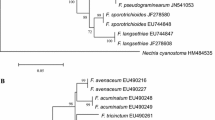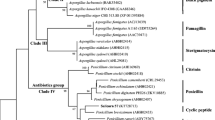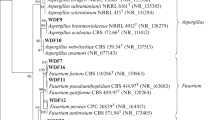Abstract
An endophytic fungus Salicorn 8 was isolated from Salicornia bigelovii Torr. and identified as Fusarium equiseti based on internal transcribed spacer gene (ITS) sequence analysis. A new glucitol, diglucotol (1), together with five known compounds, cerebroside C (2), Nb-acetyltryptamine (3), 3β,5α,9α-trihydroxy-(22E,24R)-ergosta-7,22-dien-6-one (4), cerevisterol (5) and ergosterol peroxide (6), was isolated from the culture of Salicorn 8. The chemical structures of these compounds were elucidated by extensive spectroscopic analysis and on the basis of their chemical reactivities. This work describes for the first time the isolation of these compounds from F. equiseti. Compound 1 exhibited weak antiproliferative activities toward MCF-7, MDA-MB-231 and Caco-2 cancer cells with EC50 values of 97.56, 92.35 and 99.39 μM, respectively, whereas compound 5 showed high levels of inhibitory activities against MCF-7, MDA-MB-231 and Caco-2 cancer cells with EC50 values of 32.4, 41.5 and 37.56 μM, respectively. Compound 6 exhibited less potent inhibitory activities than 5 against MCF-7, MDA-MB-231 and Caco-2 cancer cells with EC50 values of 64.5, 52.4 and 77.56 μM, respectively. All of the other compounds were found to be inactive.





Similar content being viewed by others
References
Kaul S, Gupta S, Ahmed M, Dhar M (2012) Endophytic fungi from medicinal plants: a treasure hunt for bioactive metabolites. Phytochem Rev 11(4):487–505
Guo B, Wang Y, Sun X, Tang K (2008) Bioactive natural products from endophytes: a review. Prikl Biokhim Mikrobiol 44(2):153–158
Chandra S (2012) Endophytic fungi: novel sources of anticancer lead molecules. Appl Microbiol Biotechnol 95(1):47–59
Bugni TS, Ireland CM (2004) Marine-derived fungi: a chemically and biologically diverse group of microorganisms. Nat Prod Rep 21(1):143–163
Wang X, Zhang M, Zhao Y, Wang H, Liu T, Xin Z (2013) Pentadecyl ferulate, a potent antioxidant and antiproliferative agent from the halophyte Salicornia herbacea. Food Chem 141(3):2066–2074
Park SH, Ko SK, Choi JG, Chung SH (2006) Salicornia herbacea prevents high fat diet-induced hyperglycemia and hyperlipidemia in ICR mice. Arch Pharm Res 29(3):256–264
Kang S, Kim D, Lee BH, Kim M-R, Chiang M, Hong J (2011) Antioxidant properties and cytotoxic effects of fractions from glasswort (Salicornia herbacea) seed extracts on human intestinal cells. Food Sci Biotechnol 20(1):115–122
Wang QZ, Liu XF, Shan Y, Guan FQ, Chen Y, Wang XY, Wang M, Feng X (2012) Two new nortriterpenoid saponins from Salicornia bigelovii Torr. and their cytotoxic activity. Fitoterapia 83(4):742–749
Kim YA, Kong CS, Lee JI, Kim H, Park HY, Lee HS, Lee C, Seo Y (2012) Evaluation of novel antioxidant triterpenoid saponins from the halophyte Salicornia herbacea. Bioorg Med Chem Lett 22(13):4318–4322
Zhang YH, Xue MQ, Bai YC, Yuan HH, Zhao HL, Lan MB (2012) 3,5-Dicaffeoylquinic acid isolated from Artemisia argyi and its ester derivatives exert anti-leucyl-tRNA synthetase of Giardia lamblia (GlLeuRS) and potential anti-giardial effects. Fitoterapia 83(7):1281–1285
Guo LD, Huang GR, Wang Y, He WH, Zheng WH, Hyde KD (2003) Molecular identification of white morphotype strains of endophytic fungi from Pinus tabulaeformis. Mycol Res 107(Pt 6):680–688
Zhao K, Ping W, Li Q, Hao S, Zhao L, Gao T, Zhou D (2009) Aspergillus niger var. taxi, a new species variant of taxol-producing fungus isolated from Taxus cuspidata in China. J Appl Microbiol 107(4):1202–1207
Hsiao CR, Huang L, Bouchara JP, Barton R, Li HC, Chang TC (2005) Identification of medically important molds by an oligonucleotide array. J Clin Microbiol 43(8):3760–3768
Tamura K, Peterson D, Peterson N, Stecher G, Nei M, Kumar S (2011) MEGA5: molecular evolutionary genetics analysis using maximum likelihood, evolutionary distance, and maximum parsimony methods. Mol Biol Evol 28(10):2731–2739
Liang D, Hao ZY, Zhang GJ, Zhang QJ, Chen RY, Yu DQ (2011) Cytotoxic triterpenoid saponins from Lysimachia clethroides. J Nat Prod 74(10):2128–2136
Liu RH, Sun J (2003) Antiproliferative activity of apples is not due to phenolic-induced hydrogen peroxide formation. J Agric Food Chem 51(6):1718–1723
Sun J, Liu RH (2008) Apple phytochemical extracts inhibit proliferation of estrogen-dependent and estrogen-independent human breast cancer cells through cell cycle modulation. J Agric Food Chem 56(24):11661–11667
Shu RG, Wang FW, Yang YM, Liu YX, Tan RX (2004) Antibacterial and xanthine oxidase inhibitory cerebrosides from Fusarium sp. IFB-121, an endophytic fungus in Quercus variabilis. Lipids 39(7):667–673
Li Y, Li XF, Kim DS, Choi HD, Son BW (2003) Indolyl alkaloid derivatives, Nb-acetyltryptamine and oxaline from a marine-derived fungus. Arch Pharm Res 26(1):21–23
Yaoita Y, Matsuki K, Iijima T, Nakano S, Kakuda R, Machida K, Kikuchi M (2001) New sterols and triterpenoids from four edible mushrooms. Chem Pharm Bull 49(5):589–594
Gao H, Hong K, Zhang X, Liu HW, Wang NL, Zhuang L, Yao XS (2007) New steryl esters of fatty acids from the mangrove fungus Aspergillus awamori. Helv Chim Acta 90(6):1165–1178
Sorensen JL, Akk E, Thrane U, Giese H, Sondergaard TE (2013) Production of fusarielins by Fusarium. Int J Food Microbiol 160(3):206–211
Summerell BA, Leslie JF (2011) Fifty years of Fusarium: how could nine species have ever been enough? Fungal Divers 50(1):135–144
Schoch CL, Seifert KA, Huhndorf S, Robert V, Spouge JL, Levesque CA, Chen W, Bolchacova E, Voigt K, Crous PW (2012) Nuclear ribosomal internal transcribed spacer (ITS) region as a universal DNA barcode marker for Fungi. Proc Natl Acad Sci USA 109(16):6241–6246
Marin P, Moretti A, Ritieni A, Jurado M, Vazquez C, Gonzalez-Jaen MT (2012) Phylogenetic analyses and toxigenic profiles of Fusarium equiseti and Fusarium acuminatum isolated from cereals from Southern Europe. Food Microbiol 31(2):229–237
Morrison E, Rundberget T, Kosiak B, Aastveit AH, Bernhoft A (2002) Cytotoxicity of trichothecenes and fusarochromanone produced by Fusarium equiseti strains isolated from Norwegian cereals. Mycopathologia 153(1):49–56
Kosiak EB, Holst-Jensen A, Rundberget T, Gonzalez Jaen MT, Torp M (2005) Morphological, chemical and molecular differentiation of Fusarium equiseti isolated from Norwegian cereals. Int J Food Microbiol 99(2):195–206
Shiono Y, Shibuya F, Murayama T, Koseki T, Poumale HMP, Ngadjui BT (2013) A Polyketide metabolite from an endophytic Fusarium equiseti in a medicinal plant. Z Naturforsch B J Chem Sci 68(3):289–292
Wang QX, Li SF, Zhao F, Dai HQ, Bao L, Ding R, Gao H, Zhang LX, Wen HA, Liu HW (2011) Chemical constituents from endophytic fungus Fusarium oxysporum. Fitoterapia 82(5):777–781
Wang W, Wang Y, Tao H, Peng X, Liu P, Zhu W (2009) Cerebrosides of the halotolerant fungus Alternaria raphani isolated from a sea salt field. J Nat Prod 72(9):1695–1698
Wang JW, Zheng LP, Zhang B, Zou T (2009) Stimulation of artemisinin synthesis by combined cerebroside and nitric oxide elicitation in Artemisia annua hairy roots. Appl Microbiol Biotechnol 85(2):285–292
Li H-X, Xiao Y, Cao L–L, Yan X, Li C, Shi H-Y, Wang J-W, Ye Y-H (2013) Cerebroside C increases tolerance to chilling injury and alters lipid composition in wheat roots. PLoS ONE 8(9):e73380
Wang JW, Zheng LP, Tan RX (2007) Involvement of nitric oxide in cerebroside-induced defense responses and taxol production in Taxus yunnanensis suspension cells. Appl Microbiol Biotechnol 75(5):1183–1190
Yang S-W, Cordell GA (1997) Metabolism studies of indole derivatives using a staurosporine producer, Streptomyces staurosporeus. J Nat Prod 60(1):44–48
Yaoita Y, Amemiya K, Ohnuma H, Furumura K, Masaki A, Matsuki T, Kikuchi M (1998) Sterol constituents from five edible mushrooms. Chem Pharm Bull 46(6):944–950
Lee SY, Kim JS, Lee S, Kang SS (2011) Polyoxygenated ergostane-type sterols from the liquid culture of Ganoderma applanatum. Nat Prod Res 25(14):1304–1311
Ishizuka T, Yaoita Y, Kikuchi M (1997) Sterol constituents from the fruit bodies of Grifola frondosa (Fr.) SF Gray. Chem Pharm Bull 45(11):1756–1760
Kim JA, Tay D, Blanco EC (2008) NF-κB inhibitory activity of compounds isolated from Cantharellus cibarius. Phytother Res 22(8):1104–1106
Li DH, Cai SX, Tian L, Lin ZJ, Zhu TJ, Fang YC, Liu PP, Gu QQ, Zhu WM (2007) Two new metabolites with cytotoxicities from deep-sea fungus, Aspergillus sydowi YH11-2. Arch Pharm Res 30(9):1051–1054
Liu TF, Lu X, Tang H, Zhang MM, Wang P, Sun P, Liu ZY, Wang ZL, Li L, Rui YC, Li TJ, Zhang W (2013) 3β,5α,6β-Oxygenated sterols from the South China Sea gorgonian Muriceopsis flavida and their tumor cell growth inhibitory activity and apoptosis-inducing function. Steroids 78(1):108–114
Kobori M, Yoshida M, Ohnishi-Kameyama M, Shinmoto H (2007) Ergosterol peroxide from an edible mushroom suppresses inflammatory responses in RAW264.7 macrophages and growth of HT29 colon adenocarcinoma cells. Br J Pharmacol 150(2):209–219
Takei T, Yoshida M, Ohnishi-Kameyama M, Kobori M (2005) Ergosterol peroxide, an apoptosis-inducing component isolated from Sarcodon aspratus (Berk.) S. Ito. Biosci Biotechnol Biochem 69(1):212–215
Yan D, Bao HY, Bau T, Li Y, Kim YH (2009) Antitumor components from Naematoloma fasciculare. J Microbiol Biotechnol 19(10):1135–1138
Zhao J, Zhou L, Wang J, Shan T, Zhong L, Liu X, Gao X (2010) Endophytic fungi for producing bioactive compounds originally from their host plants. Curr Res Technol Educ Trop Appl Microbiol Microbial Biotechnol 1:567–576
Strobel GA (2003) Endophytes as sources of bioactive products. Microbes Infect 5(6):535–544
Zhang HW, Song YC, Tan RX (2006) Biology and chemistry of endophytes. Nat Prod Rep 23(5):753–771
Acknowledgments
This work was financially supported by the Chinese National Natural Science Fund (No. 31071586), the Fundamental Research Funds for the Central Universities (KYZ201118) and a project funded by the Priority Academic Program Development of Jiangsu Higher Education Institutions.
Conflict of interest
None.
Compliance with Ethics Requirements
This article does not contain any studies with human or animal subjects.
Author information
Authors and Affiliations
Corresponding author
Electronic supplementary material
Below is the link to the electronic supplementary material.
Rights and permissions
About this article
Cite this article
Wang, H., Liu, T. & Xin, Z. A new glucitol from an endophytic fungus Fusarium equiseti Salicorn 8. Eur Food Res Technol 239, 365–376 (2014). https://doi.org/10.1007/s00217-014-2230-z
Received:
Revised:
Accepted:
Published:
Issue Date:
DOI: https://doi.org/10.1007/s00217-014-2230-z




